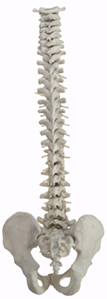 A Common Cause of Back Pain That Is Often Overlooked
A Common Cause of Back Pain That Is Often Overlooked
Sacroiliac Joint Dysfunction and the SI Fusion Procedure
By Dr. Bryan Fox
Sports Medicine and Orthopaedic Center
Chronic lower back pain can have a huge impact on one’s daily activities, and it’s one of the most common reasons patients schedule an appointment. Despite the frequency and seriousness of the issue, a major contributor is often overlooked as a pain source.
A large percentage of lower back pain cases are related to the Sacroiliac (SI) joint, which many doctors were never trained to consider. The SI joint lies next to the bottom of the spine, and connects the sacrum to the pelvis. Unfortunately, those suffering from SI joint dysfunction are often treated for spine or hip problems instead.
Strong ligaments encase the SI joint and allow for only a few millimeters of movement. When the joint becomes inflamed, either by normal wear and tear or by injury, the joint becomes painful and can become a chronic source of pain.
If your doctor thinks you may be suffering from SI joint dysfunction, it’s relatively easy to diagnose with an injection. If an injection in the SI joint blocks the pain, that’s where the problem is. If the pain comes back, the SI Fusion procedure may be considered. Fusing the bones together at the SI joint stops this mircomotion altogether and, more importantly, stops the pain for good.
The SI Fusion procedure is minimally invasive, and patient satisfaction is high. The surgeon uses a live x-ray fluoroscopy machine and performs the whole procedure through a two to three inch incision on the side of the buttocks. The surgeon inserts a metallic implant perpendicular to the joint, and the bone grows on the implant almost immediately, fusing the joint and stopping movement.
The procedure causes minimal injury to the muscles and doesn’t go near the nerves, ligaments or vascular system, and it only takes about an hour to complete. Patients typically leave the hospital the next day and can usually resume daily living activities within six weeks.
It’s important for patients to know: In most cases, you don’t have to just live with pain. There are a lot of things medical professionals can do. If you think you may be suffering from SI joint dysfunction, talk to your doctor now. The sooner you do, the sooner you can get back to doing what you want to do.<

